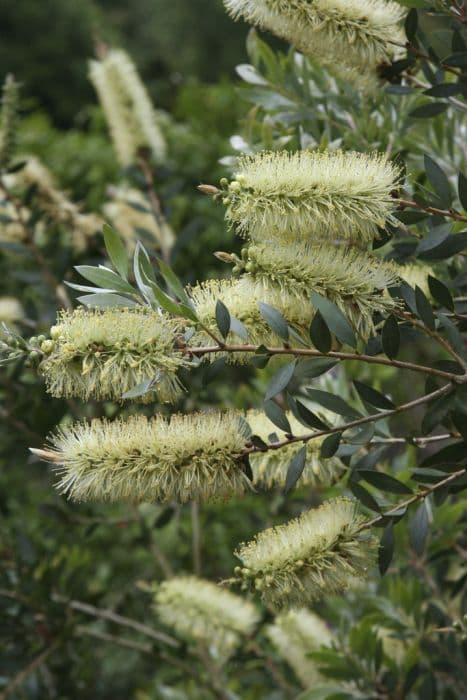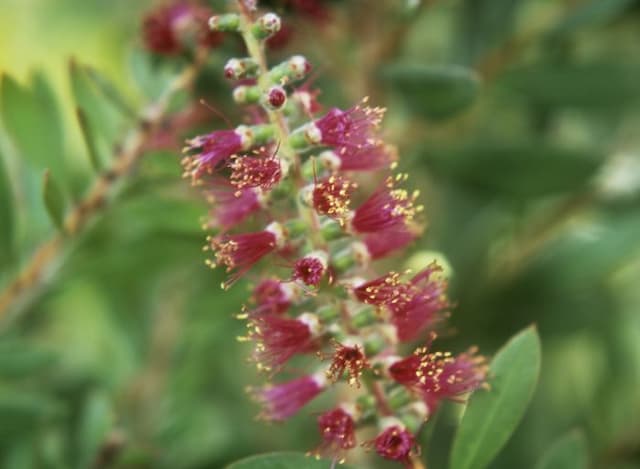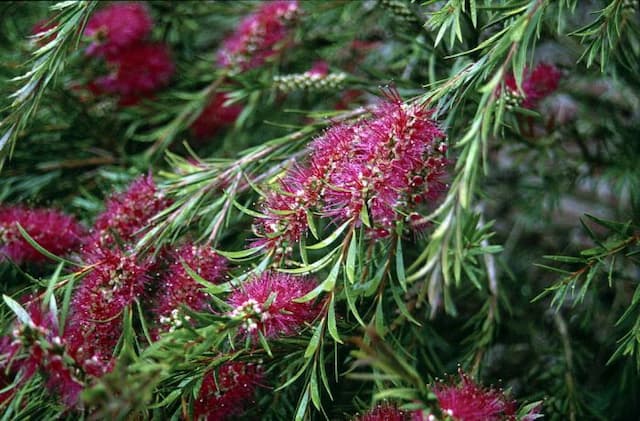Chilean Myrtle Luma chequen

ABOUT
Luma chequen, known by the common name Chequen, is a visually appealing evergreen shrub that features an interesting contrast between its bark and foliage. The bark of Chequen is known to be smooth and may present an array of different colors including shades of gray, orange, and even a reddish-brown, often exfoliating to reveal a fresh layer beneath. The leaves are small, glossy, and ovate with a leathery texture, presenting a deep green color that remains throughout the year. The Chequen blooms with petite, white flowers that cluster together in groups, giving off a quite pleasant fragrance. These flowers are followed by the appearance of small berries that change from green to black as they ripen. The overall appearance of the Luma chequen plant is dense and bushy, with a profusion of branches that provide a lush, full look. It possesses a natural elegance and is often used ornamentally in gardens to provide structure and evergreen continuity.
About this plant
 Names
NamesFamily
Myrtaceae
Synonyms
Chilean Myrtle, White Myrtle, Arrayan, Chequen, Palo Colorado, Temu
Common names
Eugenia chequen, Myrtus chequen, Myrceugenia chequen.
 Toxicity
ToxicityTo humans
The plant Luma chequen, commonly known as the Chilean myrtle, is not widely recognized for being toxic to humans. There is limited information on the toxicity of this plant to humans, and it is not generally listed among plants of concern. However, it is always important to exercise caution and not consume any parts of plants unless they are known to be safe and intended for human consumption. If an individual were to ingest parts of Chilean myrtle and experience any adverse symptoms, it is important to seek medical attention.
To pets
The plant Luma chequen, known as the Chilean myrtle, does not have a well-documented profile for toxicity in pets. There is no significant evidence to suggest that the Chilean myrtle is toxic to dogs, cats, or other household pets. However, as with any non-food plant, consumption by pets should be avoided. If a pet ingests part of a Chilean myrtle and shows any signs of illness, such as vomiting, diarrhea, or unusual behavior, it is vital to consult with a veterinarian.
 Characteristics
CharacteristicsLife cycle
Perennials
Foliage type
Evergreen
Color of leaves
Green
Flower color
White
Height
10-15 feet (3-4.5 meters)
Spread
10-15 feet (3-4.5 meters)
Plant type
Tree
Hardiness zones
8
Native area
Chile Argentina
Benefits
 General Benefits
General Benefits- Landscape Aesthetics: Luma chequen, also known as Chilean myrtle, adds ornamental value to gardens with its evergreen foliage, attractive bark, and white flowers.
- Wildlife Habitat: The plant provides shelter and food for various bird species, insects, and other wildlife.
- Low Maintenance: Once established, Chilean myrtle is drought-tolerant and requires minimal care, making it suitable for low-maintenance landscaping.
- Soil Improvement: Its root system helps to prevent soil erosion and improve soil structure over time.
- Cultural Significance: The plant has a cultural value in its native regions and is often used in traditional landscaping and ceremonial practices.
- Fragrance: The flowers and leaves of Chilean myrtle emit a pleasant fragrance, enhancing the sensory appeal of a garden or landscape.
- Hedging and Topiary: It's suitable for pruning and shaping, which makes it an excellent choice for creating hedges and topiary designs.
 Medical Properties
Medical Properties- Anti-inflammatory: Luma chequen may be used for its anti-inflammatory properties, which can help reduce inflammation and related symptoms.
- Antimicrobial: Traditionally, the plant has been used for its antimicrobial effects, which can help fight bacterial infections.
- Antiseptic: The plant has antiseptic qualities that can be useful in preventing the growth of microorganisms.
- Analgesic: Luma chequen may be used to alleviate pain due to its analgesic properties.
- Healing: It has been used to promote healing, especially in the case of wounds or skin lesions.
 Air-purifying Qualities
Air-purifying QualitiesThis plant is not specifically known for air purifying qualities.
 Other Uses
Other Uses- Dye Production: The bark and leaves of Luma chequen can be used to create natural dyes for fabric and wool, giving artisans a source of eco-friendly pigments.
- Insect Repellent: The aromatic oils in the leaves are believed to repel certain insects, making it useful in wardrobes or as a natural bug repellent.
- Woodwork: The hard, dense wood of Luma chequen is suitable for making fine furniture, flooring, and decorative objects.
- Essential Oils: The leaves of the plant can be processed to extract essential oils that are used for aromatherapy and perfumes.
- Ornamental Use: With its attractive bark and delicate flowers, Luma chequen is often used in gardens and landscapes for decorative purposes.
- Windbreaks: Luma chequen can be planted in rows to act as windbreaks, protecting crops and soil from erosion.
- Honey Production: The flowers of Luma chequen are a source of nectar for bees, leading to the production of a uniquely flavored honey.
- Live Fencing: The plant can be grown as a hedging material in agricultural fields to demarcate boundaries and provide a living fence.
- Soil Stabilization: The root system can help in soil stabilization on slopes and banks, reducing landslides and soil erosion.
- Culinary Use: Although not widespread, some parts of the plant can be used as a flavoring in cooking, similar to how bay leaves are used.
Interesting Facts
 Feng Shui
Feng ShuiThe plant Luma chequen is not used in Feng Shui practice.
 Zodiac Sign Compitability
Zodiac Sign CompitabilityThe plant Luma chequen is not used in astrology practice.
 Plant Symbolism
Plant Symbolism- Resilience: The Luma chequen, commonly known as the Chilean myrtle, thrives in a variety of environments, often symbolizing the ability to withstand and adapt to different life conditions.
- Healing: With its medicinal properties, the Chilean myrtle represents healing and the soothing of physical or emotional ailments.
- Longevity: As an evergreen plant, it can symbolize immortality and the idea of enduring life force through all seasons.
- Beauty: The delicate white flowers and attractive bark of the Chilean myrtle can represent beauty and the appreciation of visual aesthetics.
- Purification: Given its use in traditional medicine and herbal remedies, it may also stand for purification and cleansing.
 Water
WaterThe Chilean Myrtle should be watered deeply once every one to two weeks, allowing the soil to mostly dry out between waterings. During the growing season, roughly 1-2 gallons per watering should suffice for a newly planted shrub. Mature plants, however, may require more water, but always be cautious of over-watering, as the Chilean Myrtle does not like to be waterlogged. In hotter seasons or climates, increase the frequency to once a week, especially if the plant is in full sun and soil is drying out faster.
 Light
LightThe Chilean Myrtle thrives in full to partial sun. It's best planted in a location where it will receive at least six hours of direct sunlight each day. However, in extremely hot climates, some afternoon shade can be beneficial to prevent scorching of the leaves.
 Temperature
TemperatureThe Chilean Myrtle does best in temperate climates and can tolerate a range from about 20 to 100 degrees Fahrenheit. It's important to avoid exposure to temperatures below 20 degrees, as this can cause damage to the plant. The ideal temperature range for optimal growth is between 50 and 70 degrees Fahrenheit.
 Pruning
PruningThe Chilean Myrtle should be pruned to maintain its shape and encourage healthy growth. Prune in late winter or early spring before new growth starts. It’s also advisable to remove dead or damaged branches whenever they are noticed to keep the plant tidy and prevent disease.
 Cleaning
CleaningAs needed
 Soil
SoilThe best soil mix for the Chilean Myrtle (Luma chequen) consists of a well-draining, sandy loam enriched with organic matter, ideally maintaining a pH between 6.1 and 7.5. Incorporating peat moss, perlite, and compost into the soil can aid in achieving both the appropriate texture and nutrient levels for optimal plant growth.
 Repotting
RepottingChilean Myrtle (Luma chequen) doesn't require frequent repotting and can be done every 2-3 years. It's essential to repot when the plant becomes root-bound or the soil is depleted.
 Humidity & Misting
Humidity & MistingChilean Myrtle (Luma chequen) thrives best in moderate to high humidity levels, ensuring that the surrounding air isn't too dry. It can tolerate some variation but consistently higher humidity levels are preferable.
 Suitable locations
Suitable locationsIndoor
Keep Chilean Myrtle in bright, indirect light indoors.
Outdoor
Plant Chilean Myrtle in a sunny or partly shaded spot outside.
Hardiness zone
8-11 USDA
 Life cycle
Life cycleThe Luma chequen (also known as the Chilean Myrtle) life cycle begins with seed germination, which is affected by the temperature and humidity levels in its native South American habitat. Following germination, the seedling stage is marked by slow growth, as the plant develops its root system and initial leaves. As it enters the juvenile phase, the Chilean Myrtle experiences more rapid growth, forming a more structured woody stem and branching pattern. In the adult stage, the plant reaches reproductive maturity, producing white to pale pink flowers which, after pollination, develop into small, purple-black berries. The berries contain seeds which, once dispersed by birds or gravity, have the potential to germinate and start the life cycle anew. The Chilean Myrtle can live for many years, transitioning through periods of growth and dormancy with the seasons.
 Propogation
PropogationPropogation time
Spring to Summer
The Chilean Myrtle, more formally known as Luma chequen, can be propagated through semi-hardwood cuttings. This is considered the most popular method. During the late summer or early fall, when the current season's growth has begun to mature, cuttings of about 4 to 6 inches (10 to 15 centimeters) long can be taken. It's important to select healthy, disease-free shoots and make a clean cut just below a leaf node. The leaves on the lower half of the cutting should be removed, and the cut end may be dipped in rooting hormone to promote root development. The prepared cutting should then be inserted into a well-draining growing medium, such as a mixture of perlite and peat, and kept in a warm location with indirect light. Keeping the medium moist but not waterlogged is vital, and if the conditions are right, the cuttings will root in several weeks to a few months.









